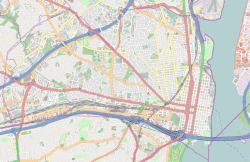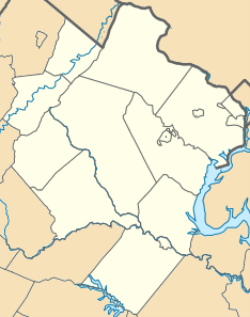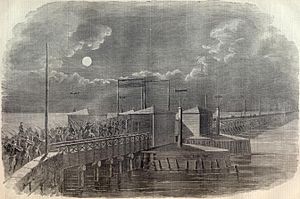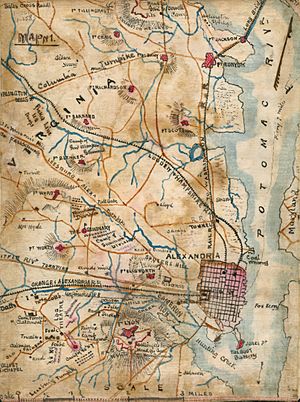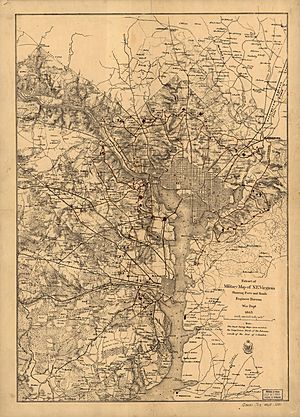Fort Ward (Virginia) facts for kids
|
Fort Ward
|
|
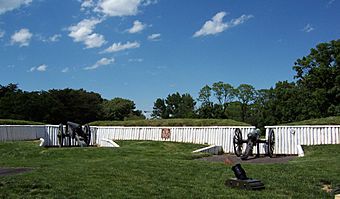
Fort Ward's restored Northwest Bastion
|
|
| Location | 4301 W. Braddock Rd., Alexandria, Virginia |
|---|---|
| Area | 35 acres (14 ha) |
| Built | 1861 |
| Built by | Union Army Corps of Engineers |
| NRHP reference No. | 82004538 |
Quick facts for kids Significant dates |
|
| Added to NRHP | August 26, 1982 |
| Fort Ward | |
|---|---|
| Part of the Civil War defenses of Washington, D.C. | |
| Alexandria, Virginia | |

Gateway near the path between the museum and remnants of the fort
|
|
| Type | Earthwork fort |
| Site information | |
| Owner | City of Alexandria |
| Controlled by | Union Army |
| Open to the public |
Yes |
| Condition | Stabilized |
| Site history | |
| Built | 1861 |
| Built by | U.S. Army Corps of Engineers |
| In use | 1861–1865 |
| Materials | Earth, timber |
| Demolished | 1865 |
| Battles/wars | American Civil War |
Fort Ward is a historic Union Army fort located in Alexandria, Virginia. It was one of the largest forts built to protect Washington, D.C. during the American Civil War. Today, Fort Ward is very well-preserved, with most of its original earthen walls still standing. It serves as a museum and a place where visitors can learn about this important time in American history.
Contents
Protecting Washington, D.C.
Before the Civil War began, the area near Washington, D.C., in Virginia was mostly farmland. The city of Alexandria was the main town. In 1861, the war started after Fort Sumter was attacked. President Abraham Lincoln called for soldiers to stop the rebellion. This made more southern states, including Virginia, decide to leave the Union.
Union Army leaders worried that Confederate soldiers might place cannons on the hills of Virginia. These cannons could easily fire at government buildings in Washington, D.C. To prevent this, they decided to occupy Northern Virginia and build forts. However, they waited until Virginia officially voted to leave the Union.
On May 23, 1861, Virginia voted to secede. That very night, Union troops began crossing the bridges from Washington, D.C., into Virginia. Thousands of soldiers marched across the Long Bridge and Chain Bridge. They quickly took control of the important areas.
The occupation was mostly peaceful, except in Alexandria. There, a Union officer named Colonel Elmer E. Ellsworth was killed while taking down a Confederate flag. He was one of the first soldiers to die in the Civil War. His killer was then also killed by Union soldiers. Alexandria remained under Union control throughout the war.
Building Defenses After Battle
After occupying Northern Virginia, the Union Army started building forts along the Potomac River. These forts protected the bridges connecting Virginia to Washington and Georgetown. Soon, plans were made for a much larger ring of forts to defend the city from all directions.
This construction work was paused in mid-July 1861 when soldiers marched south to fight in the First Battle of Bull Run. The Union Army lost this battle. Afterward, there was a panic in Washington, D.C., as people feared a Confederate attack. Quick efforts were made to build temporary defenses.
Five days after the battle, George B. McClellan became the commander of the Union Army in the Washington area. He was shocked by how weak the city's defenses were. He ordered a massive expansion of Washington's defenses. New forts and trenches were built everywhere to stop any attack. Alexandria was especially important because it had a large port and a canal.
Fort Ward's Design and Construction
Fort Ward was named after Commander James H. Ward, the first Union naval officer to die in the war. The fort was first designed with walls stretching 540 yards and platforms for 24 cannons. Later, a powerful 100-pound Parrott gun was added. By 1863, the fort's perimeter was expanded to 818 yards, with space for 36 guns.
General John Newton oversaw the building of Fort Ward and other forts south of Four Mile Run. Many "contrabands" – enslaved people who had escaped to Union lines – helped build these defenses. They played a crucial role in protecting Washington, D.C.
Fort Ward never saw any battles or attacks during the war. It was taken apart in November 1865 after the war ended. Many African Americans who had helped build the fort continued to live in the area for many years.
Fort Ward Museum and Historic Site
Today, Fort Ward is a 45-acre Fort Ward Museum and Historic Site in Alexandria, Virginia. It is located next to Braddock Road. The museum has changing exhibits about the Civil War and a library filled with Civil War books.
The site is listed on the National Register of Historic Places. It often hosts exciting reenactments of both the Civil War and the Revolutionary War. Visitors can explore the museum, see a reconstructed Officer's Hut, a Ceremonial Gate, and a rebuilt northwest section of the fort. You can find it at 4301 West Braddock Road.
In the early 1960s, the city of Alexandria bought the land to prevent it from being turned into a housing development. The city then rebuilt parts of the old fort and created the park we see today.


